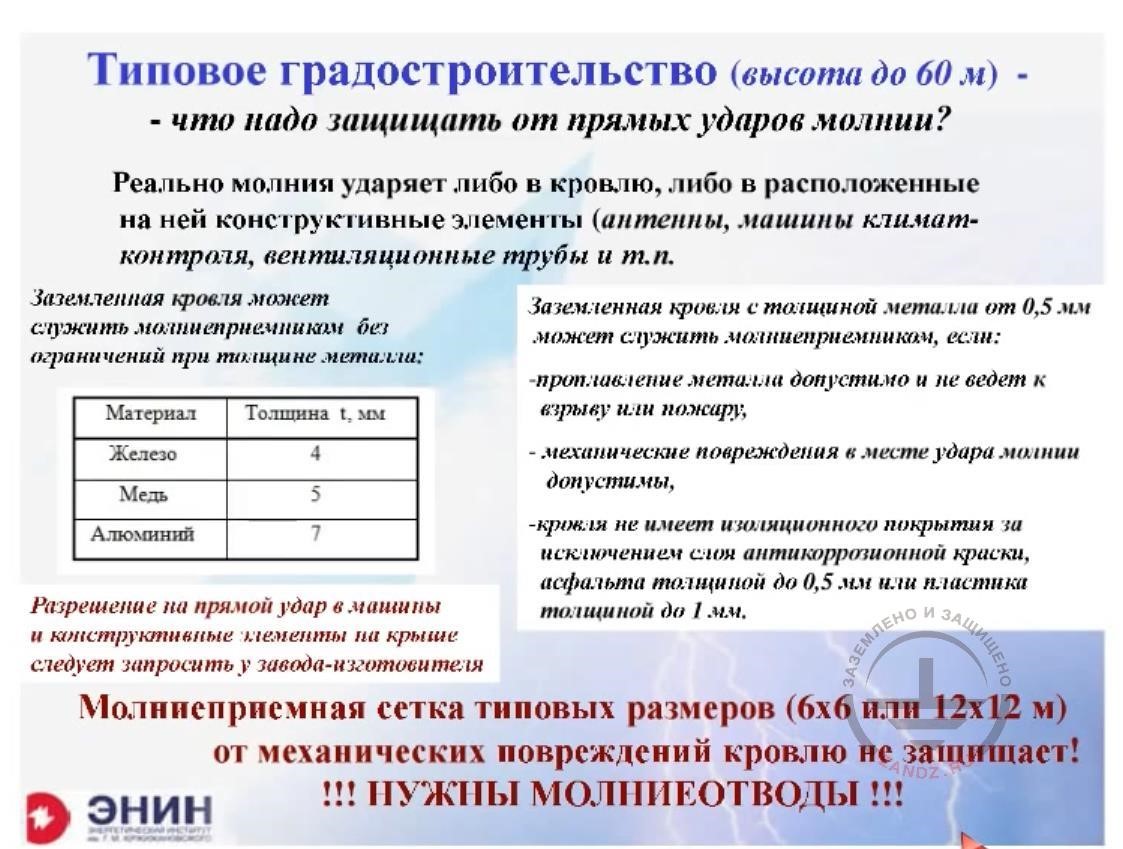The second webinar of Grounding and lightning protection: answering frequently asked design questions series
(ended on July 30, 2014, at 11:00 MSK)
Recommended streaming quality is 1080p in a full-screen mode.
We will start with lightning risk assessment for individual buildings, and then specify the method to calculate the expected number of lightning strikes into a facility. This is easy to do when the building has a simple configuration. But if the height of its individual parts is different, there is a number of other facilities of comparable height or the surrounding terrain is complex, then computational difficulties may arise.
After that, we will talk about the electromagnetic influence of lightning strike on electrical circuits in the building. They may occur much more frequently than a direct lightning strike, and the consequences are often fatal. That's why the presentation will be held in a reverse order, starting with the details about internal lightning protection.
When reviewing the external lightning protection, we will focus on protecting the roof of a building against direct lightning strikes. The modern approach to this issue will be discussed on the example of widely used roofing materials having a low metal thickness, which can be definitely burned through by the lightning strike. Special attention will be paid to low-height air terminals, including mesh cages.
The drain of the lightning current is not a problem when the walls of a building are made of non-flammable materials. But in the case, if the finishing materials are inflammable, then the task becomes more complicated and requires a special analysis. Even a more noteworthy problem is arranging the safe down conductors in places where people can touch their surfaces.
Finally, we will discuss the grounding of residential buildings. Here we'll talk about the use of concrete foundations and the arrangement of additional ground loops in low conductivity soils.
Webinar text. Page 1
Quick navigation through slides:
Page:1
1. Protecting the private housing
2. RD 34.21.122-87 regulatory requirements
3. SO-153-34.21.122-2003 requirements
4. RD 34.21.122-87 minimum requirements
5. Expected number of direct lightning strikes
6. Influence of adjacent structures
7. Electromagnetic effects of lightning
8. Lightning proofing capacity of buildings
9. Typical urban development
Estimated reading time: 1 hour 15 minutes
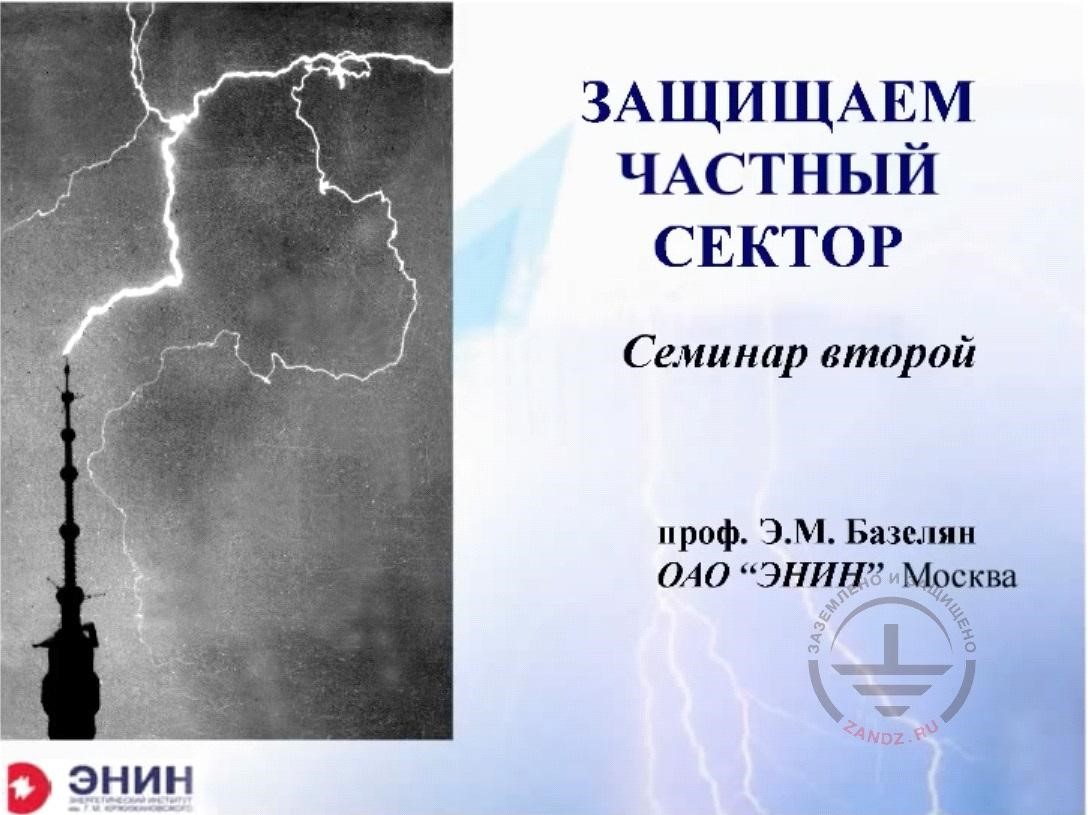
Protecting the private housing
| RU | EN |
| Защищаем частный сектор | Protecting the private housing |
| Семинар второй | Webinar 2 |
| Проф. Э. М. Базелян | Prof. E. M. Bazelyan |
| ОАО ЭНИН, Москва | ENIN JSC, Moscow |
Dear colleagues! It's been a pleasant surprise for me that we are meeting again in less than a month. I was told that a serious storm season is ongoing, so an active design works are in progress. Therefore we don't have to wait for the autumn and need to continue our seminars immediately.
This is exactly what we are going to do. I suppose our conversation will take 50 minutes together with the presentation. And then, perhaps, I'll try to answer your questions for up to half an hour, if our hosts can bear such a long conversation. The pretentious title "Protecting the private housing" has its own history. You know, if you take the RD 34, you'll find out that this standard pays virtually no attention to the protection of buildings where people live and work. It is necessary to protect public buildings, but let the private housing burn — just forget about them. When we started preparing this workshop, we saw the following: regulatory requirements specified in the RD 34 are at least strange and bewildering.
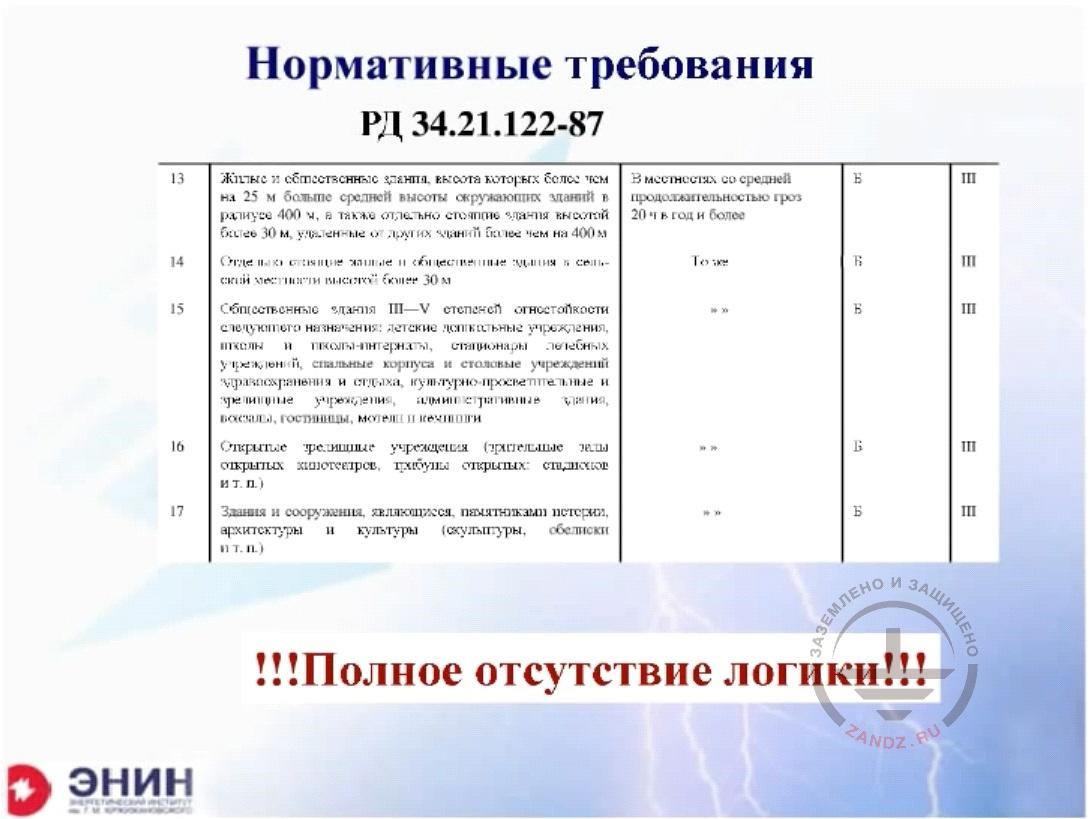
RD 34.21.122-87 regulatory requirements
| EN | RU |
| Нормативные требования | Normative document requirements |
| РД 34.21.122-87 | RD 34.21.122-87 |
| !!! Полное отсутствие логики!!! | !!! Logic totally absent!!! |
Please look at Table 1 of this standard. Page 2 says that residential buildings and structures should be protected in the case when they are 25 meters higher than the surrounding buildings. You know, it looks like no big houses and no residential buildings need protection. And it's absolutely unclear what you need to protect. You need to protect cow sheds, as they are mentioned in the table. And it is not clear what to do with the houses because the demands specified in the standard are drawn up in such a way that essentially no residential buildings require lightning protection.
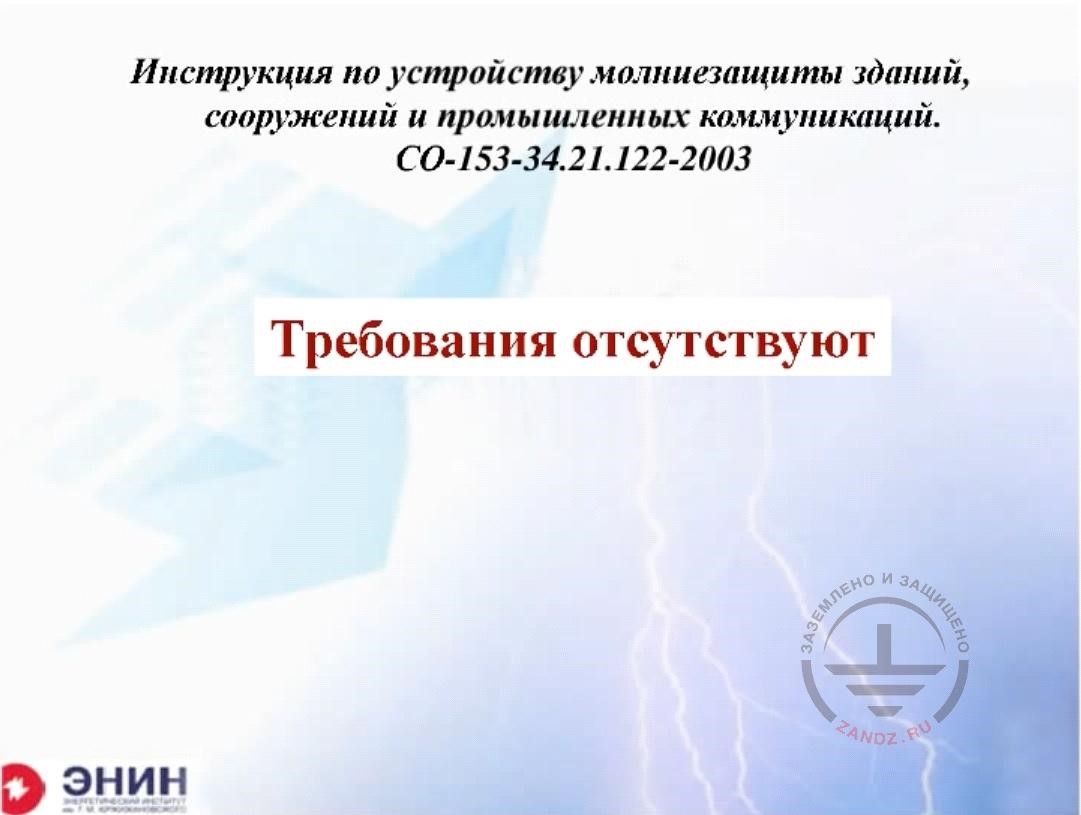
SO 153-34.21.122-2003 requirements
| RU | EN |
| Инструкция по устройству… | Buildings, structures and industrial communications lightning protection instructions. SO-153-34.21.122-2003 |
| Требования отсутствуют | Requirements are absent |
And you have to talk to your customers in this situation. If we turn to Western standards, they are quite simple, as lightning protection requirements are essentially mandated by insurance companies there. If an insurer comes to your house and you have a lightning protection system installed, then you have to pay one amount, but if there is no lightning protection then the amount will be different. But Russian insurance companies do not even ask whether you have a lightning protection. So designers do not understand what they should do. I propose to proceed as follows:
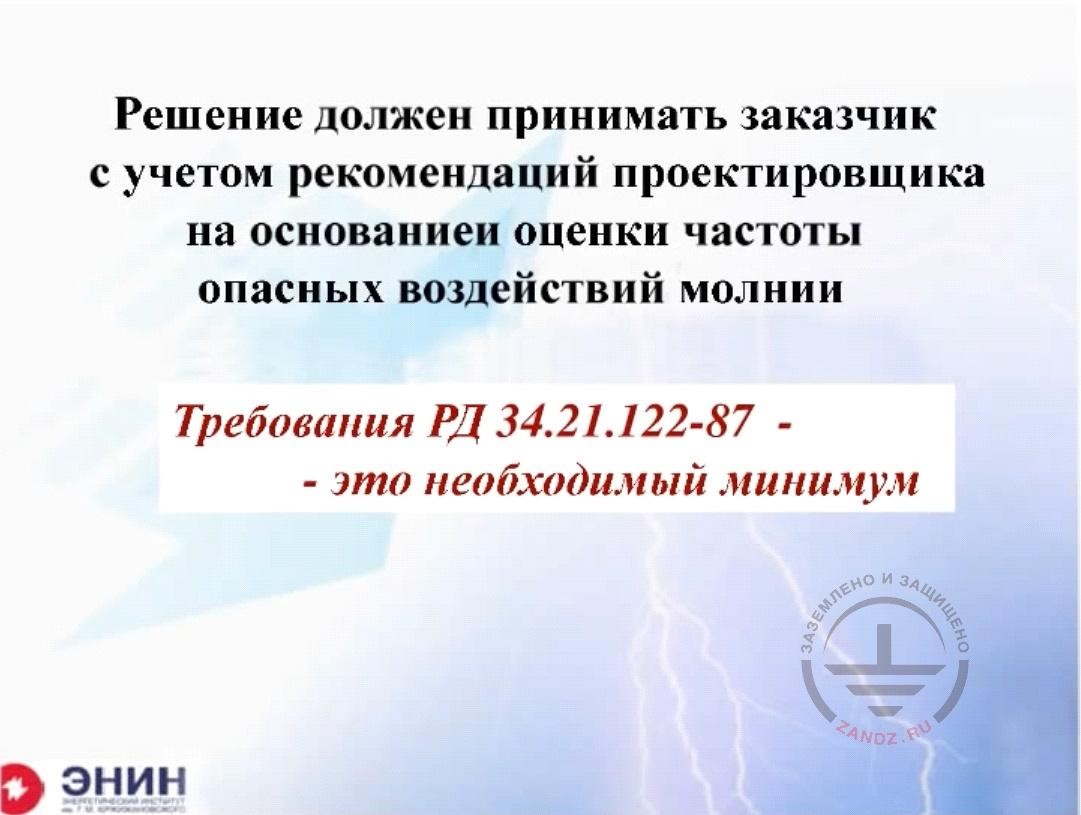
RD 34.21.122-87 requirements: the necessary minimum
| RU | EN |
| Решение должен принимать заказчик… | The decision is to be made by the customer with consideration of designer’s recommendations based on the estimation of hazardous lightning effect frequency |
| Требования РД 34.21.122-87… | RD 34.21.122-87 requirements is the necessary minimum |
You cannot violate RD 34 requirement under any circumstances for the simple reason that if you do violate them, then Gostekhnadzor not let this building put into operation. But you can treat these requirements as a minimum that needs to be followed. And as for everything beyond that, then nobody will forbid you doing it. So when you begin talking with your customer, the first thing you have to explain is as follows:
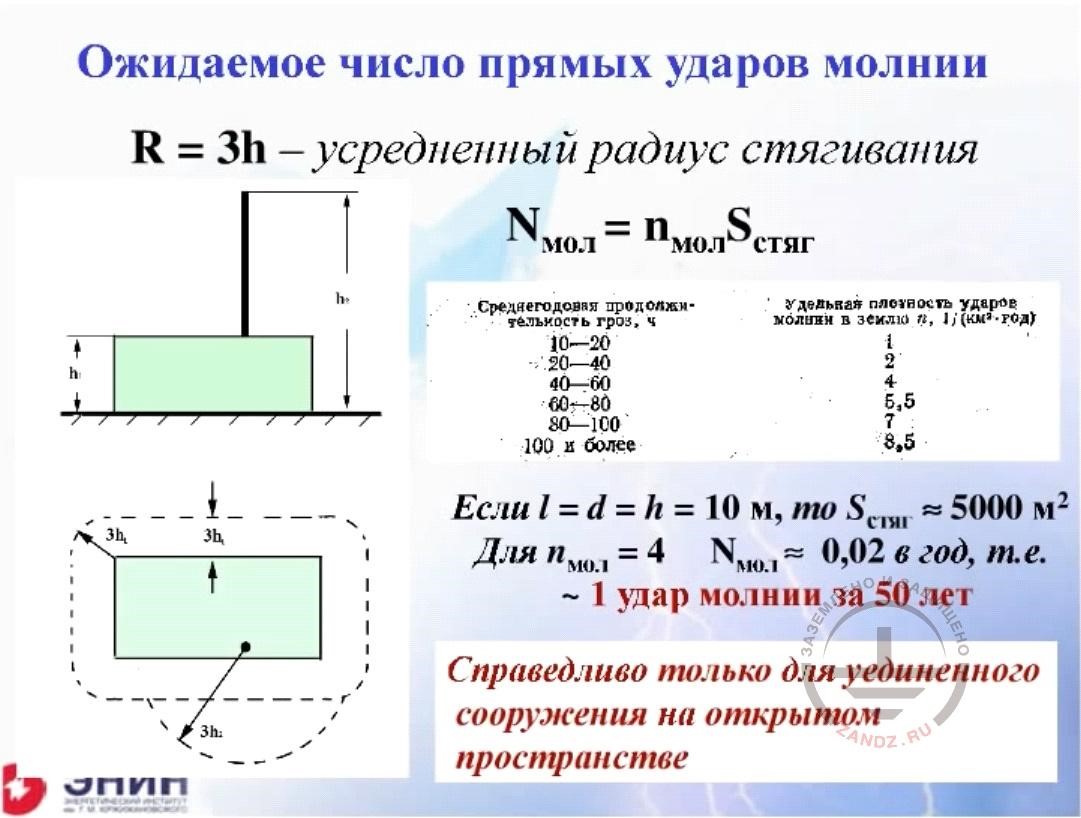
Expected number of direct lightning strikes
| RU | EN |
| Ожидаемое число прямых ударов молнии | Expected number of direct lightning strikes |
| R=3h – усредненный… | R=3h – an average attraction radius |
| Nмол=nмолSстяг | Nlight=nlightSattr |
| Среднегодовая продолжительность гроз, ч | Average annual thunderstorm duration, hours |
| Удельная плотность ударов молнии в землю, n l I (км2 год) | Specific density of lightning strikes into the ground, N l l (km2 per year) |
| 100 и более | 100 and more |
| Если l=d=h=10 м, то Sстяг ≈5000 м2 Для nмол =4 Nмол≈0,02 в год, т.е. ~1 удар молнии за 50 лет |
If l=d=h=10 m then Sattr ≈5000 m2 For nlight =4 Nlight≈0,02 per year, i.e. ~1 lightning strike per 50 years |
| Справедливо только для уединенного сооружения на открытом пространстве | It is true only for a stand-alone structure on the open space |
How seriously his building can be damaged by a lightning strike. For example, you are designing a single-family house and tell the customer: "I'm ready to count how many times and in how many years your future home can be struck by lightning. It is very simple to do. The whole world accepts that a building having a height h attracts lightning at the neighborhood area, the size of which is determined by three heights of the building. If I draw a distance equal to three heights of your house along its perimeter, then this will be just the area dangerous for your building. I can calculate this area in any way, even in a squared sheet of paper. Then I multiply the area by the specific density of lightning strikes (in the Russian Federation, it is in the range of 1 to 5. In the midland regions, somewhere between Moscow and St. Petersburg, the approximate figure will be 3). If I multiply the area measured in square kilometers by the specific density of lightning discharges, then I get the number of lightning strikes per year. But if we are talking about a small mansion with a height of 10 m, a length 10 m and a width of 10 meters, then the lightning attraction area will be roughly 5,000 square meters. And if I multiply this number by 4 (the average value for the Russian midland), then I get 0.02 lightning strikes per year. This means one strike in 50 years on average. Such an assessment is easy to do if you have buildings of the same height. But if your buildings have different heights (I've shown the simplest case in the picture: I assume that I have an antenna tower on the building), then you need to do the following things: you need to calculate attraction radii for each height.
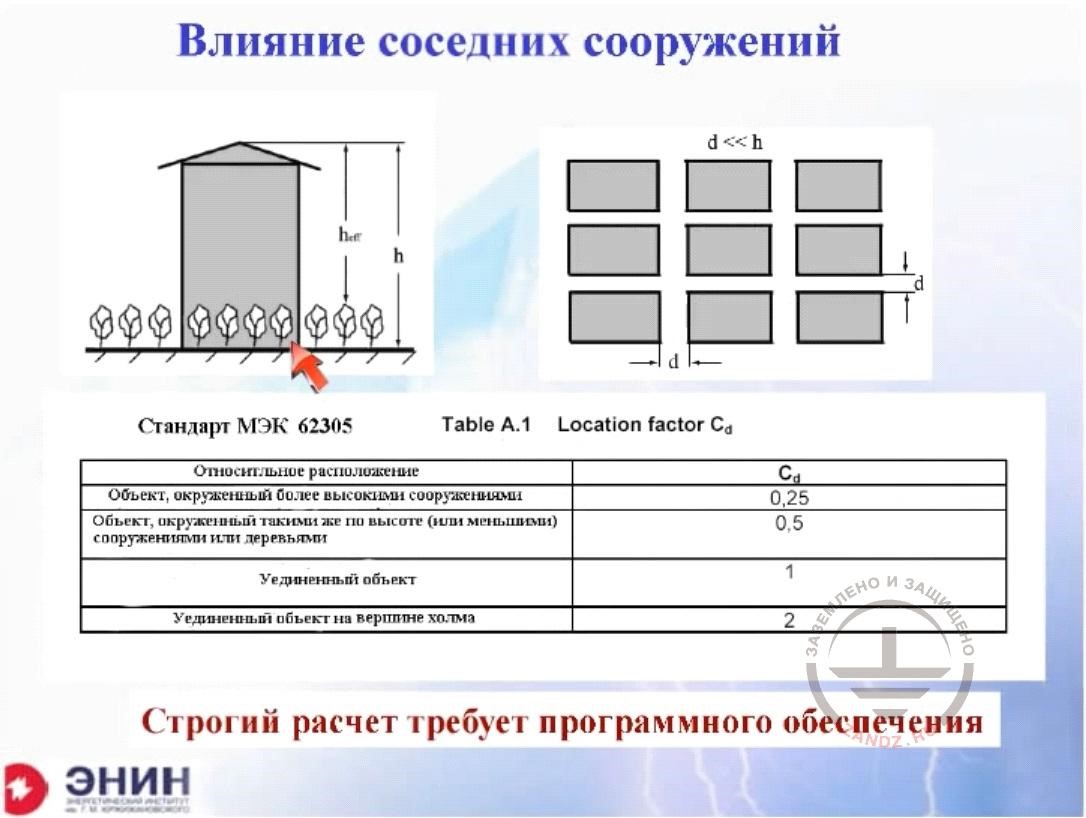
The influence of neighboring structures
| RU | EN |
| Влияние соседних сооружений | The influence of neighboring structures |
| Стандарт МЭК 62305 | IEC 62305 |
| Относительное расположение | Relative location |
| Объект, окруженный более высокими сооружениями | Facility surrounded by higher structures |
| Объект окруженный такими же по высоте… | Facility surrounded by structures of structures or trees of the same height (or smaller) |
| Уединенный объект | Stand-alone facility |
| Уединенный объект на вершине холма | Stand-alone facility on the top of the hill |
| Строгий расчет требует программного обеспечения | Exact calculations require software |
But what I've just said works only for a stand-alone building, i.e. if there are no other facilities next to it. If there are other buildings there, then the attraction areas of different buildings can overlap. And in case if they overlap, then the calculation process becomes very difficult. The trouble is that if all adjacent buildings have roughly the same height, then the overlapped areas can be divided equally between the buildings. But if the buildings have different heights, then a lot of confusion happens. If I look through the regulations of other countries, e.g. if I look through the International Electrotechnical Commission's (IEC) lightning protection standard, then I'll find that they've managed this in a very simple way: they've assigned different correction coefficients to different situations. Where did they get these correction coefficients? The International Electrotechnical Commission has never told anyone. And where coefficients from the table I have here emerged from? I cannot even imagine this. See what happens if my building is surrounded by buildings of a greater height, I have to reduce the number of strikes by a factor of four, i.e. apply the correction factor of 0.25. Why 0.25? Nobody knows that. If I have a facility of about the same or smaller height, then I should take the coefficient of 0.5 (no one knows why, again). Finally, if I have a stand-alone building, then the coefficient is 1, and if the building is on a mountain, then you need to take a correction coefficient of 2. And this is despite the fact that if the building is on the mountain, the number of strikes can be increased fivefold or tenfold or whatever you like. Thus, the recommendations by the International Electrotechnical Commission absolutely do not stand up — they do not hold water at all. None of them does. Every last one of them was pulled out of a hat. How to manage this situation?
Generally speaking, the only way out of this situation is as follows. The firm, which is hosting this webinar today, offers a software product. We handed over this software to the company, and it will be available to you if you need to calculate the expected number of lightning strikes in the most difficult situation when the building is located in urban areas with high-rise buildings nearby. All this can be calculated if you need it. But in reality, you will need this on rare occasions, and that's why: all the figures of the expected number of strikes is very approximate. A twofold error here counts for nothing. Imagine that you tell your potential customer that his building will have one lightning strike every 50 years.
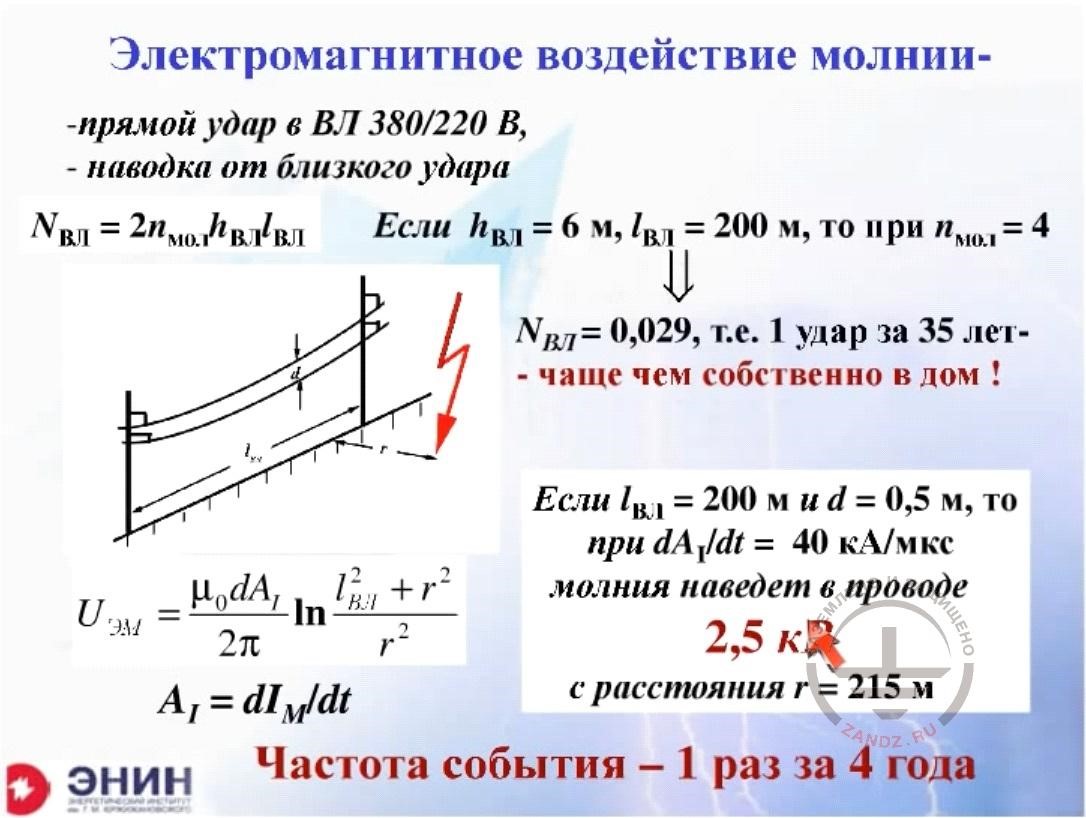
The electromagnetic effects of lightning
| RU | EN |
| Электромагнитное воздействие молнии - | The electromagnetic effects of lightning |
| - прямой удар в ВЛ 380/220 В, | - direct lightning strike into an 380/220 V overhead line |
| - наводка от близкого удара | - EMI from the close strike |
| Nвл=2nмол hвл lвл | Nol=2nlight hol lol |
| Если hвл = 6 м, lвл=200 м, то при nмол = 4 | If hol = 6m, lol=200 м, then at nlight = 4 |
| Nвл = 0,029, т.е. 1 удар за 35 лет | Nol = 0,029, i.e. 1 strike in 35 years |
| - чаще, чем собственно в дом! | - more frequently then directly into the house! |
| Если при lвл=200 м и d=0.5 м, то при dAi/dt=40 kA/мкс | If at lol=200 m and d=0.5 m, then at dAi/dt=40 kA/mcs |
| Молния наведет в проводе | The lightning will cause EMI in the wire |
| 2,5 кВ | 2,5 kV |
| С расстояния r=215 м | from a distance of r=215 m |
| Частота события – 1 раз за 4 года | Event frequency is 1 time in 4 years |
Then you have to tell your customer the following: the highest danger to your future building is not a direct lightning strike, which is really quite a rare event, but a lightning strike or electromagnetic induction in the power line, which enters your building. Outside large Russian cities, you can rarely come across a line with contiguous phase carried out as insulated wires. Generally, a distance of 40 to 50 cm between phase wires and the same distance to the neutral conductor is maintained. These wires form quite a big loop, and the loop between the wires falls under the effect of a lightning field. And voltage surges occur because of the lightning field. When a lightning strikes into the power line, the surge is even stronger. This is despite the fact that the height is about 6 m for a 220 V overhead power line. The line from your home to the substation can be several hundred meters long. The area gets bigger and about 0.03 bolts of lightning can strike the line during one year. That translates into about 1 strike in 35 years, and if you remember, the previous value was one strike in 50 years. The probability increases, but that's not all. A strong bolt of lightning induces an electromagnetic field in the wires, which is dangerous for the insulation of your home. Insulation in your house can withstand a voltage of about 2.5 kV and the insulation of wires permanently on in the circuit is designed for a substantially smaller voltage, for example, 1 kV. An average lightning excites this voltage at a distance of more than 200 m and the probability of such a lightning strike becomes quite significant, i.e. about one strike in 4 to 5 years. And if you tell the customer all these things, he will probably scratch his head and ask you how much it will cost to make a lightning protection you offer. The interest will surely be more pronounced and more serious here.
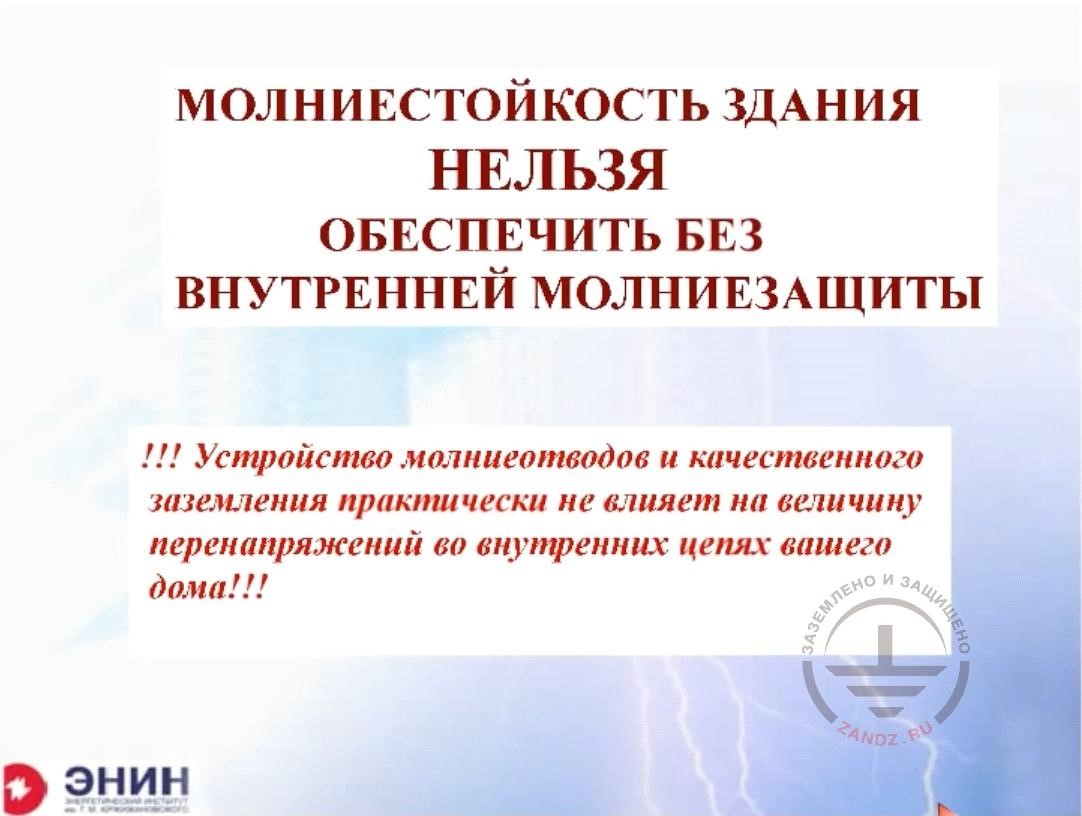
Lightning proofing capacity of buildings
| RU | EN |
| Молниестойкость здания нельзя… | Lightning proofing of the building cannot be obtained without internal lightning protection |
| !!!Устройство молниеотводов… | !!!The arrangement of air terminals and high-quality grounding has almost no effect on the surge in the internal circuits of your house!!! |
So, you have to tell the customer that you cannot provide lightning protection of his buildings without taking care about the internal lightning protection, that is, the protection of which is associated with surges on power line! No lightning rods will ever ensure the reliable protection of buildings. The reliable protection consists of two components. The first component is aimed to block the surge, which comes through a power line, and the second component is protection against direct lightning strikes using lightning rods. That's how you have to explain the situation to your customer.
| RU | EN |
| Типовое градостроительство… | Typical urban development (the height up to 60 m) |
| - что надо защищать от прямых ударов молнии? | - what should be protected from a direct lightning strike? |
| Реальная молния ударяет либо… | In reality, the lightning strikes either into roofing or into structures on it (antennas, climate control equipment, ventilation pipes etc.) |
| Заземленная кровля может служить молниеприемником без ограничения при толщине металла: | A grounded roof can serve as an air terminal without limitations on the metal thickness: |
| Материал | Material |
| Толщина t, мм | Thickness, t, mm |
| Железо | Iron |
| Медь | Copper |
| Алюминий | Aluminum |
| Разрешение на прямой удар… | A permission for a direct lightning strike into machinery should be asked from the manufacturer |
| Заземленная кровля с толщиной…. или пластика толщиной до 1 мм. | The grounded roof with metal thickness 0.5 mm and thicker can serve as an air terminal if: - metal meltdown is acceptable and does not cause fire or explosion, - mechanical damage at the points of lightning strike are acceptable, - the roof has no waterproofing coating excluding a layer of anti-corrosion paint, asphalt with a thickness up to 0.5 mm or plastic up to 1 mm. |
| Молниеприемная сетка типовых размеров… | Lightning protection mesh cage of typical size (6x6 or 12x12 m) does not protect roofing against mechanical damage! !!!AIR TERMINALS ARE NEEDED!!! |
Now, let's start with a traditional thing, i.e. air terminals. What do you need to protect inside your building? Your building is usually built from brick or concrete, but if this is a wooden house, it will still have metal roofing because even modern roof tiles used today are metal tiles. As for the old asbestos roofing slates, they aren't in use anymore nowhere the world because of environmental and cancer-causing effect, so you won't want to use such roofing slates. Can you use your roof as an air terminal? Is it possible to prevent lightning strikes directly into the roof? It is possible beyond doubt if the thickness of your roofing is about 4 mm for iron, 5 mm for copper or 7 mm for aluminum. And nobody has ever made such a roof in his or her own house, as it is expensive, unreasonable and useless. The roof is made from metal profile sheets or from metal tiles. And the thickness of a metal layer in the metal tile is only 0.5 mm. The question is whether it is allowed to use these metal tiles and metal profile as air terminals?
Next Page >>
Slides 10 to 18
Useful materials for designers:
- Webinars with the leading industry experts
- Everything for the calculation of grounding and lightning protection
- Useful materials: articles, recommendations, examples
Related Articles:
 Lightning protection of residential and public buildings - answers to frequently asked questions in the design
Lightning protection of residential and public buildings - answers to frequently asked questions in the design
 Lightning Protection of Large Territories: Parks, Grounds, Plant Territories. Page 1
Lightning Protection of Large Territories: Parks, Grounds, Plant Territories. Page 1
 Lightning Protection of Large Territories: Parks, Grounds, Plant Territories. Page 2
Lightning Protection of Large Territories: Parks, Grounds, Plant Territories. Page 2
 Lightning Protection of Large Territories: Parks, Grounds, Plant Territories. Page 3
Lightning Protection of Large Territories: Parks, Grounds, Plant Territories. Page 3


